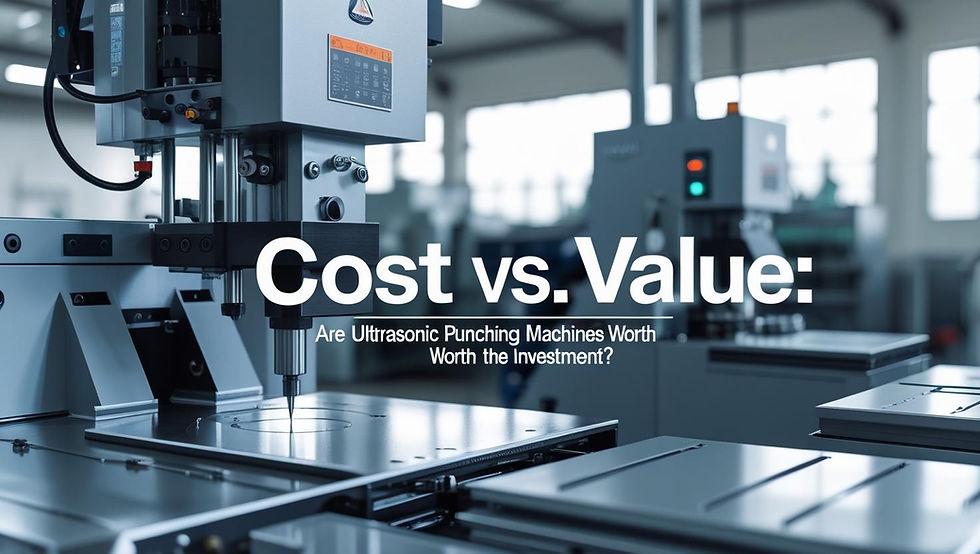Choosing the Right Ultrasonic Cloth Cutting Machine for Your Business Needs
- ztzgsteeltech
- Jun 4
- 3 min read

In the fast-paced world of textile and garment production, precision and efficiency aren't just goals—they're necessities. And at the core of achieving these objectives lies a crucial decision:
Choosing the right ultrasonic cloth cutting machine for your business needs. Whether you run a small tailoring operation or a high-volume textile factory, the right machine can elevate your output, reduce waste, and improve product quality.
But how do you choose the right one with so many models, sizes, and specifications available? This comprehensive guide breaks down the key considerations to ensure you make an informed, cost-effective, and performance-driven choice.
Understanding Ultrasonic Cloth Cutting Technology
Before diving into the decision-making factors, it’s essential to grasp what makes ultrasonic cloth cutting unique. Unlike traditional blades, ultrasonic cutters use high-frequency sound waves to generate friction and heat, slicing through fabrics with seamless precision. The result? Clean edges, sealed seams, and no fraying—especially vital for synthetic and delicate textiles.
Types of Ultrasonic Cloth Cutting Machines
Understanding the types of machines available is the first step in finding a perfect match.
Handheld Ultrasonic Cutters
Ideal for small-scale or custom jobs requiring flexibility and mobility.
Tabletop Ultrasonic Cutting Machines
Great for medium operations needing stability and repeated cutting accuracy.
Fully Automated Ultrasonic Cutting Systems
Best suited for large-scale manufacturing with high-volume requirements and integrated workflow needs.
Key Factors to Consider When Choosing the Right Machine
1. Type of Material
Different fabrics react differently to ultrasonic cutting. Synthetic fibers such as polyester, nylon, and polypropylene respond best due to their ability to melt and seal.
Ask yourself:
Are you cutting primarily synthetic, blended, or natural fabrics?
Will the machine need to handle layered or reinforced materials?
2. Production Volume
The scale of your production should directly influence your machine selection.
Low volume: A handheld or small bench-top unit is sufficient.
Medium to high volume: Consider semi-automated or fully automated cutters with conveyor systems.
3. Cutting Precision and Complexity
Are your projects simple or intricate? High-precision parts like automotive fabrics, medical garments, or lace require machines with:
Adjustable amplitude
Consistent frequency
Micro-controlled cutting heads
4. Power and Frequency Requirements
Most ultrasonic machines operate between 20kHz to 40kHz. A higher frequency means finer cuts, which is ideal for delicate textiles, while lower frequencies work better for thicker materials.
5. Safety and Ergonomics
Operators should work efficiently and safely.
Choose machines with ergonomic designs for prolonged use
Built-in safety features like emergency stops, protective casings, and auto-shutoff enhance workplace safety
6. Budget Constraints and ROI
Balance the initial investment against long-term ROI.
Handheld devices may be cheaper but offer limited automation
Automated systems save time and labor in the long run, justifying higher costs
Additional Features to Look For
Digital control panels for easy adjustments
Automatic feeding mechanisms
Built-in cooling systems for heat-sensitive operations
Multi-functional use: some machines offer sealing, embossing, and trimming
Industry Use Cases
Garment Manufacturing
Seams sealed with ultrasonic cutters are stronger and more aesthetic
Commonly used for lingerie, sportswear, and uniforms
Medical Textiles
Cuts must be precise and hygienic
Ultrasonic cutters reduce contamination by sealing edges
Automotive Upholstery
Thick, layered materials demand powerful ultrasonic systems
Ensures consistent patterns and wear resistance
Maintenance and After-Sales Support
Even the best machines need care.
Choose a supplier that offers warranty, training, and replacement parts
Regular maintenance checks improve machine lifespan and cutting quality
Zrintech, for example, is known for its excellent customer support and machine reliability, ensuring that your investment continues to deliver.
Mistakes to Avoid When Buying
Choosing a machine without assessing your specific fabric types
Prioritizing cost over cutting accuracy and build quality
Ignoring the need for technical support and training
Overlooking upgrade options as your business grows
Conclusion
Choosing the right china ultrasonic cloth cutting machine for your business needs is about balancing performance, precision, and practicality. Whether you're producing bespoke garments, medical gear, or automotive components, an optimized ultrasonic cutter can elevate both your output and quality standards.
Take time to evaluate your material types, production demands, budget, and long-term goals. When done right, the investment pays off in reduced waste, faster production, and superior end products.
FAQs
What materials are best suited for ultrasonic cutting?
Synthetic fabrics, such as polyester, nylon, and thermoplastics, respond best to ultrasonic cutting.
Is ultrasonic cutting safe for delicate textiles?
Yes. Higher-frequency machines offer gentle, fray-free cutting ideal for delicate materials.
Can I use ultrasonic cutters for large-scale production?
Absolutely. Automated systems are designed for high-volume, consistent performance.
Do ultrasonic cutters require specialized training?
Basic training is needed, but most systems are user-friendly and easy to operate.
What are the maintenance requirements?
Routine cleaning and regular calibration checks keep machines running smoothly.



Commentaires